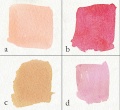Difference between revisions of "Category:Gamboge: Ukiyo-e colorant"
(Created page with "== Description == Sappanwood (suo): in progress <gallery> Sappsnwood trees.JPG|Sappanwood (''Caesalpinia sappan'') File:brazilwood raw.jpg|Cut pieces of brazilwood...") |
|||
| Line 1: | Line 1: | ||
== Description == | == Description == | ||
| − | [[ | + | Gamboge (): A yellow-orange gum-resin produced by several species of ''Garcinia'' tree found in India, Thailand, Cambodia, Vietnam, and Ceylon. Gamboge was used as a yellow pigment as early as the 8th century in Asia and Japan. It was regularly imported to Europe in the 17th century but a few earlier deliveries may have occurred. Gamboge is composed of a yellow resinous component (70-80%; morelloflavone) and a clear water-soluble [[gum]] (20%). Gamboge is marketed in the form of dull, brownish-yellow cakes or lumps. When powdered, it has a rich golden color. Gamboge is used as a transparent colorant in glazes, varnishes, and watercolors. The carbohydrate gum acts as a natural binder. The yellow color fades when exposed to light or [[ozone]]. In some cases it has recovered its color when placed in the dark. |
| − | <gallery> | + | |
| − | + | <gallery>| | |
| − | File: | + | File:gamboge_pieces_1.jpg|Gamboge pieces |
| + | File:296 gamboge.jpg|Gamboge, powdered | ||
File:Red bud_suo.jpg|Red bud | File:Red bud_suo.jpg|Red bud | ||
File:12 Sappanwood.jpg|Sappanwood, poowdered | File:12 Sappanwood.jpg|Sappanwood, poowdered | ||
File:06_Brazilwood comp.jpg|Dye mixtures from brazilwood juice | File:06_Brazilwood comp.jpg|Dye mixtures from brazilwood juice | ||
| − | + | Gamboge color.PNG|EEM Color | |
</gallery> | </gallery> | ||
Revision as of 12:25, 29 April 2020
Description
Gamboge (): A yellow-orange gum-resin produced by several species of Garcinia tree found in India, Thailand, Cambodia, Vietnam, and Ceylon. Gamboge was used as a yellow pigment as early as the 8th century in Asia and Japan. It was regularly imported to Europe in the 17th century but a few earlier deliveries may have occurred. Gamboge is composed of a yellow resinous component (70-80%; morelloflavone) and a clear water-soluble Gum (20%). Gamboge is marketed in the form of dull, brownish-yellow cakes or lumps. When powdered, it has a rich golden color. Gamboge is used as a transparent colorant in glazes, varnishes, and watercolors. The carbohydrate gum acts as a natural binder. The yellow color fades when exposed to light or Ozone. In some cases it has recovered its color when placed in the dark.
Examples
Pages in category "Gamboge: Ukiyo-e colorant"
The following 12 pages are in this category, out of 12 total.
G
K
- Kiyomasu I, Courtesan Reading a Poem, 28.198
- Kiyomasu II, Actor Ogino Izaburô I as Yamagami Gennai, Acting in the Aragoto Style with the Sumikazura Wig, 11.13297
- Kiyomasu II, Actors Segawa Kikunojô I as Yomogiu, Ichikawa Ebizô II as Tono no Hyôe, and Yamamoto Kyôzô as Kureha, 21.5459
- Komatsuken, Courtesan Parading with Two Kamuro, 11.19711
- Komatsuken, Young Man as the Bodhisattva Monju, 11.30137
- Komatsuken, Young Woman as the Bodhisattva Fugen, 11.30136





